By Jeffrey A. Rendall, Photos by Scot Rendall
RANCHO MIRAGE, CA – Pete Dye is known for designing some brutishly difficult golf courses, but his creation at the Westin Mission Hills Resort isn’t one of them.
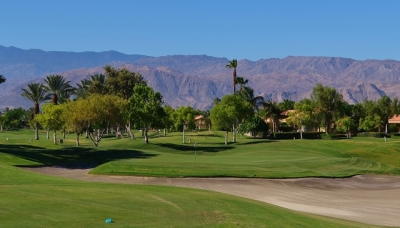 |
| The par three 3rd hole features an enormous bunker, but most of it is just for show. |
When you mention Dye’s name in conjunction with the Palm Springs area, you’ll probably think first of PGA West, where Dye’s Stadium layout continually ranks among America’s toughest golf courses with a slope of 150 from the back tees.
Opening in 1986, the Stadium Course was a big hit with golf course design enthusiasts, who marveled at the track’s astonishingly difficult targets and stunning scenery. Many who witnessed the Skins Game or the Hope (played only one year there) probably looked on with ghoulish delight as the layout time and again humbled the game’s best professionals (and some celebrities, too).
And for those duffers brave enough to try it themselves – you may just be serving up some crow for the post-round meal.
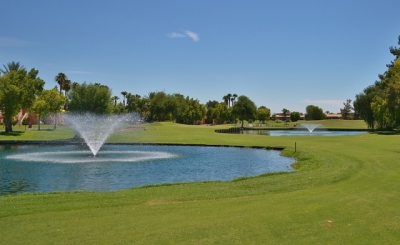 |
| Water frames the landing areas on the difficult par four 14th hole. |
In contrast, there’s another Dye layout just a short drive away that hardly leaves the same impressions. Found at the Westin Mission Hills Resort, this ‘gentle' Dye course opened three years after his Stadium piece, yet shares only a few characteristics in common with its pitiless older relative.
In other words, what Dye taketh away at PGA West, he giveth back at Mission Hills. Or maybe he was just in a better mood in the late 80’s when the Dye course was laid out.
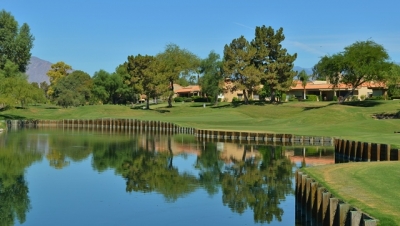 |
| Railroad ties and bulkheads - you know you are at a Pete Dye course. Here, the par three 8th hole. |
Playing to 6706 yards (par 70) from the back tees and a relatively tame slope of 131, you’ll still find many Dye trademarks at Mission Hills -- although you probably won’t pay for ‘em with as many golf balls.
In characteristic Dye fashion, there’s plenty of water, pot bunkers and railroad ties on the Pete Dye Resort Course. In addition, the fairways are rolling, there are some target-oriented greens, and the putting surfaces are tricky and fast.
Unlike its Stadium sibling, however, the Mission Hills Resort course doesn’t have any 250 yard par threes and there are ‘only’ two par fours over 423 yards. Its two par fives are possibly reachable for long-hitters (one definitely is), and there aren’t any 20-foot high bunkers or Sahara-sized waste areas. Finally, there are only a couple carries that would rate in the ‘scary’ category.
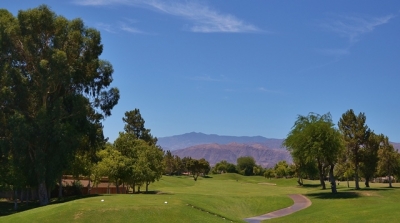 |
| The playing areas are wide, but missing the fairway still has its consequences on the Dye Course. Here, the par four 15th hole. |
And fortunately, like PGA West, Mission Hills has tour-quality playing surfaces. Troon Management ensures that players find the layout in excellent shape year-round (with the course being closed about three weeks in October for over-seeding).
Perhaps another factor helping with pristine conditions is the Mission Hills Resort lies adjacent to the famous Mission Hills Country Club, home of the LGPA’s first major championship of the season, the Dinah Shore/Kraft Nabisco tournament. Lucky for the resort golfer, it seems many of the top-notch conditions the women pros find next door have made their way to the resort.
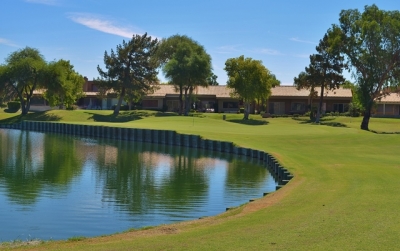 |
| Water guards the green of the #1 handicap par four 7th hole. |
In fact, the back nine of the Pete Dye course was at one time part of Mission Hills Country Club. Mission Hills Resort acquired the nine holes from its famous neighbor and Pete Dye made it part of the current eighteen.
In playing the course, one of the most surprising elements about Mission Hills (being a Dye course) is its forgiving nature off the tee. Most holes have incredibly wide driving avenues, and while failing to find the fairway will most likely punish you with a thick Bermuda rough lie – or end up behind a tree -- you won’t be marking down the requisite penalties you’d endure elsewhere.
Further, several of the par fours can be attacked by an iron or fairway wood off the tee and a short iron to the green, and the fairways’ mounding may even kick the ball towards a flatter area.
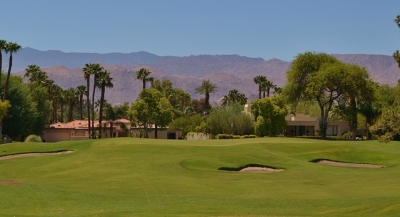 |
| Another elevated green tests you at the par three 16th hole. |
Jon Vesper, the Pete Dye Resort Course’s Director of Golf, pinpoints the challenging aspects: “The course is really protected by its green complexes. Surrounded by deep bunkers, the greens typically are elevated with several false fronts and runoff areas that are mown very tight. There are also a few holes where water borders the green, making no room for error.”
One final note before describing some of the highlight holes is the Troon Fit / Walk the Westin program. Anyone who’s played a fair amount in the desert knows that walking is a rarity on resort courses. During the summer, the heat is a very good reason to take a cart.
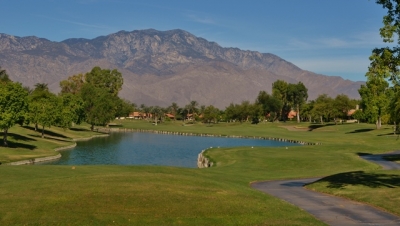 |
| From the back tees of the par five 5th hole, you must choose how much of the lake you want to challenge. |
But during the more temperate times of the year, most golf courses become very walkable – and one of the best examples is the Westin Pete Dye Resort Course. The Troon program includes a pedometer, water bottle, calorie tracker, lunch and the round of golf.
Can you think of a better way to get in shape and have a little fun at the same time?
Looking at the course highlights, Dye starts out with a good warm-up par four, 372 yards in length. There’s a huge bunker right smack in the middle of the viewing area, but it’s got plenty of room to either side and can even be flown at 210 yards from the back tee.
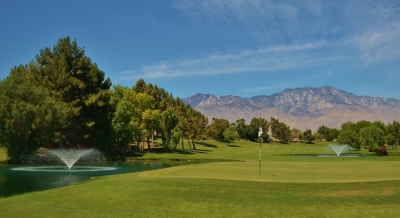 |
| Even though the Dye Resort Course is in the middle of a residential neighborhood, the views are unspoiled and spectacular. |
One of the most intriguing holes is number six. Just 330 yards from the back, you can even hit driver safely on the hole. The interesting part stems from a green that is protected by a large mound to the right side. If you approach from that direction, you’re firing blind, and you’ll probably even need to scale the mound before you hit in order to see where the pin position is.
Eight is vintage Pete Dye, a beautiful 197-yard par three with a full water carry to a railroad-tie framed green. This hole looks like it was taken from Dye’s famous Harbour Town layout on Hilton Head Island. Tons of room to bail right if you can’t stomach the carry, and only one bunker to avoid.
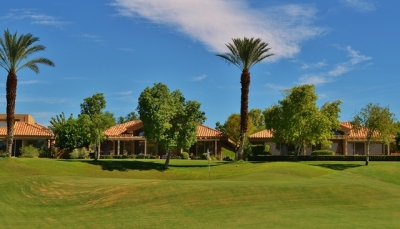 |
| The short par four 6th hole has an elevated green that will keep you honest. |
Turning to the back nine, twelve is a reachable par five at 506 yards in length. Bunkers squeeze the landing area at a driver’s length from the tee. If you choose to lay-up, favor the left side as two large bunkers protect the right side of the green. The fairway on this hole is somewhat undulating, so it’s likely you won’t have a flat lie to hit your longer clubs, should you decide to try for the green in two.
Fourteen is a tremendous par four. From the back tees, you’re shooting through a chute of trees. You’ll need to carefully select your driving club, because a lake juts into the landing area from the left side, and the fairway is sloped on the right. For the approach to the green, you’ll need to avoid water on the right and a large greenside bunker to the left. Par here is a great score.
Eighteen is a classic Dye finishing hole. Reasonably short at 385 yards, the tee shot is slightly downhill with water on the left, and a steep slope to the right. For those who choose driver, bunkers await long and right. Water hugs the entire left side of the green and short landing area, and if you’re too strong on the approach, you’re also wet. This hole could easily ruin a good score!
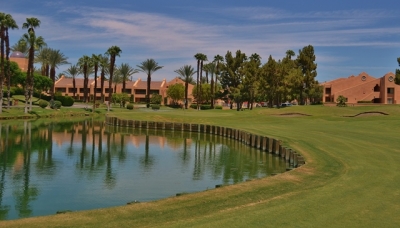 |
| Pete Dye always designs tough closing holes, and the par four 18th at Mission Hills is no exception. |
Vesper agrees. “Pete Dye is known for making a golfer work hard on his or her last few holes to score well. That holds true for both the front and back nine here on the Resort Course. The front nine at the Westin finishes with two long par fours and a long par three over water. These are thought to be the toughest holes on the golf course.”
Vesper continues, “The back nine finishes parallel with the resort pool and golf shop with water spanning the entire left side of the hole. Pete Dye put emphasis on a tough tee shot as well as a tough approach to the green. These finishing holes are the highlight of the course.”
As an observation, the Westin Pete Dye course’s surroundings are quite built-up, as the desert living environment is growing ever more popular. But the houses don’t spoil the incredible views of the San Jacinto Mountains. The residences are situated far enough back where they really shouldn’t come into play, and the residents themselves are good neighbors.
A final note about the Westin Pete Dye Course is the attentive service. Driving into Mission Hills, you’re greeted by the Resort’s personnel, and your bag’s taken care of from there on out. There’s a reason why this resort has the Westin name attached to it, and you certainly won’t have to worry about doing much for yourself.
To sum up, the Mission Hills Pete Dye course is quite a contrast from Dye’s PGA West Stadium course. It’s the difference between a devilishly difficult trip through Pete Dye’s considerable imagination versus a smooth but challenging cruise through his ‘gentle’ side.
Details:
The Westin Mission Hills Resort (Pete Dye Course)
71333 Dinah Shore Drive
Rancho Mirage, CA 92270
Director of Golf: Jon Vesper, PGA
Course Architect: Pete Dye
Rates:
Rates range anywhere from $75-$160, depending on the time of year and time of day. The Westin does offer stay and play packages and often runs special packages with merchandise and golf throughout the year.
| Related Links | Comments on this article? | |
|
Maryland National Golf Club Hollow Creek Golf Club Rocky Gap Resort PB Dye Golf Club in Ijamsville Whiskey Creek Golf Club |
E-mail Jeff Rendall, Editor: jrendall@golftheunitedstates.com |












